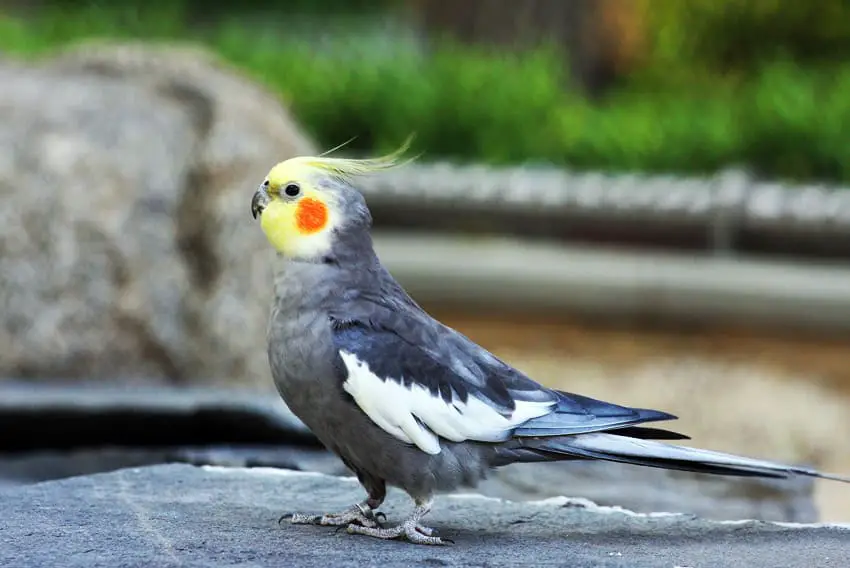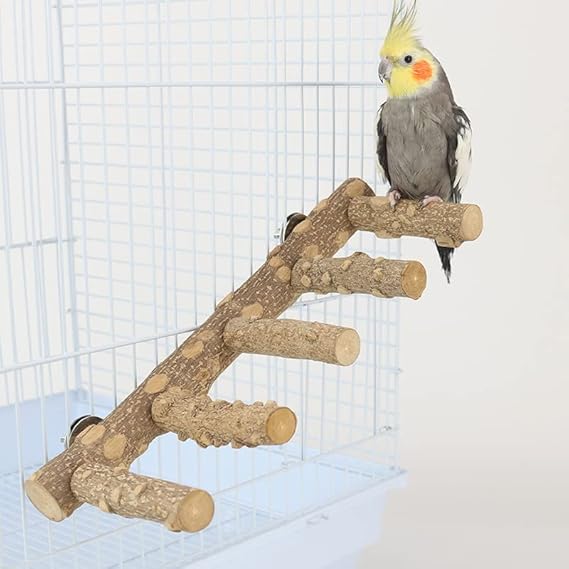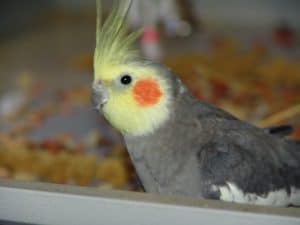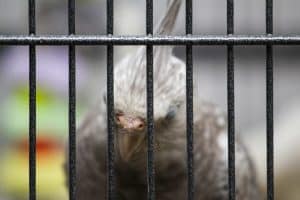Step into the captivating world of cockatiel bird language and behavior, where every chirp, whistle, and gesture carries profound meaning. As a cockatiel owner, mastering the intricacies of these charming birds’ unique communication style can turn everyday interactions into joyful conversations. Cockatiels, celebrated for their sociable and loving personalities, employ a sophisticated array of sounds and actions, each meticulously crafted to convey specific messages in their daily lives.
By deciphering these signals, you’ll not only strengthen your bond but also ensure the well-being and happiness of your feathered companion. Whether you’re a novice owner or seeking to deepen your connection with your bird, exploring the intricacies of cockatiel communication promises a captivating journey. Join us as we delve into the expressive world of cockatiels, unraveling the secrets behind their distinctive language and behavior.
Understanding Cockatiel Behavior
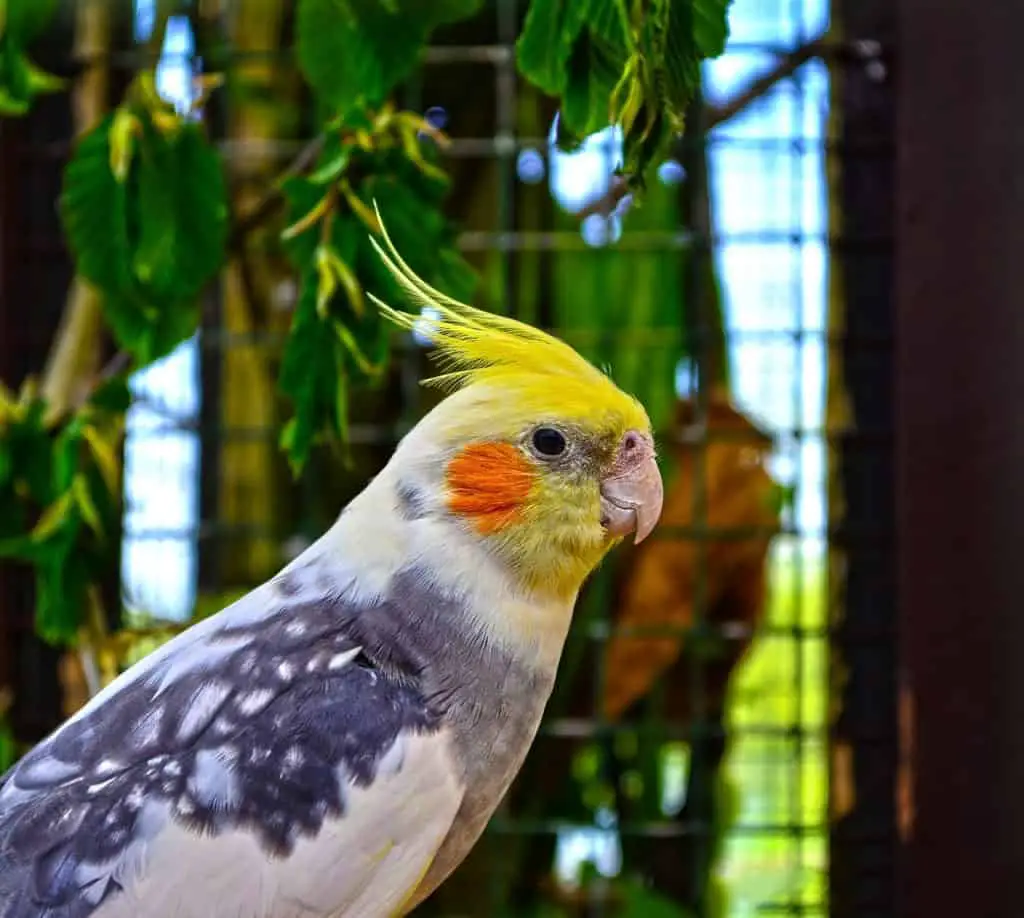
Grasping the various behaviors of cockatiels entails observing a multitude of visual and auditory signals. These signals help you better understand your pet’s needs and emotions, enhancing your ability to care for them effectively.
Visual Signals
Cockatiels communicate extensively through body language. One prominent feature is the crest feathers; a raised crest generally means your cockatiel is startled or highly curious, while a flattened crest might indicate fear or aggression. Observing the positioning of tail feathers also provides clues about their emotional state. Tail fanning often occurs during aggressive displays, whereas slow tail wagging can signify contentment. Additionally, watch for signs like feather plucking which might indicate stress or health issues, prompting a visit to an avian veterinarian.
Auditory Communications
The sounds cockatiels make are equally telling. A content cockatiel often engages in beak grinding, which is a sign of relaxation, usually before bed time. On the other hand, sharp and repeated screams may be an alarm call, indicating distress or seeking attention. Listen closely to the pitch and frequency of these sounds; understanding these can help you discern their immediate feelings and needs. Remember, consistent vocalizations towards other birds or even their own reflection can indicate a desire for interaction or, conversibly, a display of territoriality.
Common Cockatiel Behaviors
Observing common behaviors in your cockatiel can provide invaluable insights into its health and emotional state. Recognizing what is normal and what indicates potential distress helps ensure that your feathered friend remains healthy and happy.
Positive Indications
Understanding positive cockatiel behaviors enhances your ability to cater to their needs effectively. When your cockatiel is content, you’ll notice several cheerful signs:
- Head bobbing and wing flapping: These actions generally mean your cockatiel is in a playful mood and seeking attention.
- Crest feathers raised: A slightly raised crest can indicate curiosity or excitement, especially when new toys or other birds are present.
- Tail wagging: This fluid motion is typically a sign of a relaxed and happy bird. It’s similar to the tail wag of a joyful dog and shows that your cockatiel feels safe and content in its environment.
These behaviors are great indicators of a healthy bird that feels safe and engaged in its surroundings.
Signs of Distress or Illness
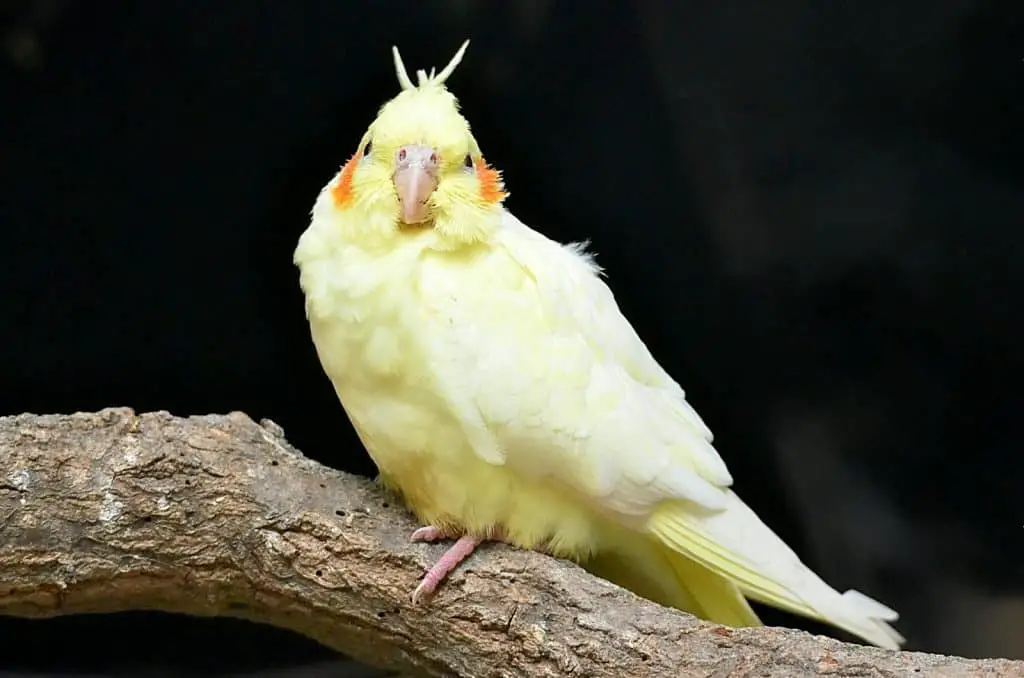
On the other hand, recognizing signs of distress or illness is crucial for the wellbeing of your cockatiel. Immediate attention might be necessary if you observe the following:
- Feather plucking: This is often a response to stress, environmental factors, or illness. Consistent feather plucking should prompt a visit to an avian veterinarian.
- Beak grinding or flattened crest: While beak grinding can sometimes signify contentment, accompanied by a flattened crest, it may indicate illness or nervousness.
- Changes in vocalization: Excessive screaming or changes in the normal chirping pattern can signal distress or discomfort. This behavior warrants closer observation to determine the cause.
Spotting these signs early often enables you to provide the necessary care or medical attention, maintaining your cockatiel’s health and comfort.
Interpreting Your Cockatiel’s Vocalizations
Understanding the variety of sounds your cockatiel makes is crucial for gauging its emotions and overall well-being. Cockatiels are naturally communicative and their vocalizations can provide insights into their mood and health.
Common Sounds and Their Meanings
Cockatiels produce a range of sounds, each with distinct meanings. Recognizing these can enhance your bond and help you respond to their needs more effectively.
- Whistling and Singing: This behavior is a sign of happiness and contentment. If your cockatiel whistles or sings, it’s likely feeling secure and engaged in its environment. These sounds are common when your pet is seeking attention or reacting to pleasurable stimuli, such as your arrival home or the sound of music.
- Hissing: This sound usually indicates fear, discomfort, or aggression. It often occurs if someone unknown approaches the bird’s cage or if they feel threatened by nearby activities or other pets.
- Beak Grinding: Often heard when a cockatiel is content and relaxed, typically just before falling asleep. This soft grinding noise is a sign of a calm and healthy bird.
Each vocalization serves as a window into your feathered friend’s current state of mind, allowing you to respond appropriately and maintain a peaceful and happy environment for them.
Improving Interaction with Your Cockatiel

T
o deepen your understanding and strengthen your relationship with your cockatiel, it’s crucial to interact effectively, responding appropriately to their unique language and behaviors. Below, you’ll find essential tips for engaging positively with your feathered friend, ensuring a rewarding companionship.
Tips for Positive Engagement
Utilize Consistent Communication: Consistency in your interaction forms the bedrock of a strong bond. Engage regularly by talking to your cockatiel throughout the day using a calm and gentle tone. If they respond with chirps or whistles, acknowledging this communication fosters an environment of mutual understanding and trust.
Offer Physical Affection Appropriately: Cockatiels often enjoy physical contact such as gentle head scratches or being stroked along their back. Watch for their body language cues; a raised crest or relaxed feathers generally means they’re enjoying the interaction, while a flattened crest or retreating might indicate it’s time to give them space.
Incorporate Training and Mental Stimulation: Training sessions using simple commands can be both entertaining and mentally stimulating for your cockatiel. Use treats to reward desired behaviors, reinforcing positive actions and deepening your bond. Introduce new toys into the cage to keep their environment stimulating, which can help prevent behaviors like feather plucking or excessive vocalization due to boredom.
By understanding and adapting to your cockatiel’s unique forms of expression and needs, you cultivate a deeper, more empathetic connection with your avian companion. Engaging with them considerately according to their preferences and responses ensures a happy, healthy pet who feels loved and understood.
- Perfect Sizethis natural wood perches length is 12.2 inch while the twig length is 4 inch. The perfect size for parrots, parakeets, budgies, lovebirds, hamsters, etc. Please check the size carefully before purchasing.
- 100% Natural WOODperches for bird cages Made of natural prickly white wood, green, non-toxic, harmless, impact resistant, durable, non-shrinking and non-cracking. The nut and washer are made of stainless steel, durable. Natural prickly ash wood is suitable for birds to chew and eat, and is also a good place for birds to relax and play.
- Easy to installthis bird perches for parrots Designed with a flexible single lock removal, it can be installed in almost any cage.
- Wide Applicablethis natural wood perches also suitable for hamsters, guinea pigs, chinchillas, rats, etc.
Understanding Your Cockatiel’s Body Language
Interpreting your cockatiel’s body language is crucial for understanding its emotions and health. Here’s a closer look at key aspects of their body language:
Head Feathers and Tail Feathers: Observing your cockatiel’s head feathers can provide valuable insights. Raised head feathers often indicate curiosity or alertness, while flattened feathers may suggest fear or aggression. Tail feathers, when spread or twitching, can signal excitement or nervousness.
Recognizing Signs of Illness: As responsible bird owners, recognizing signs of illness in cockatiels is essential. A sick bird may exhibit lethargy, fluffed feathers, or changes in appetite. Changes in tail feather position, such as drooping or unusual angles, can also indicate discomfort or illness.
Dealing with Aggressive Behavior: Cockatiels, like all pets birds, may display aggression due to various reasons. Understanding their body language during such episodes—flattened crest, hissing, or rapid head movements—can help diffuse tense situations and address underlying causes like stress or territorial behavior.
Maintaining Healthy Birds: Maintaining a healthy environment is key to preventing illness in pet birds. Regular veterinary check-ups, a balanced diet, and providing mental stimulation through toys and interactions are crucial for keeping cockatiels happy and healthy.
Empowering Bird Owners: By familiarizing yourself with your cockatiel’s body language and vocalizations, you can effectively respond to their needs. This knowledge strengthens the bond between bird owners and their feathered companions, ensuring a fulfilling and harmonious relationship.
Understanding Cockatiel Behavioral Nuances
Cockatiels, with their expressive crests and engaging vocalizations, offer a unique window into the avian world. By understanding their nuanced behaviors, you can provide a nurturing environment that promotes their well-being and happiness.
Advanced Visual Signals
Eye Pinning: Eye pinning, or the rapid dilation and contraction of a cockatiel’s pupils, often occurs during heightened emotional states. This behavior can indicate excitement, curiosity, or agitation. For example, if your cockatiel’s pupils are pinning while they are chirping or engaging with a toy, they are likely excited and engaged. However, if eye pinning accompanies hissing or aggressive posturing, it’s a sign of distress or territorial behavior.
Feather Ruffling: Cockatiels often ruffle their feathers as a way of relaxing or adjusting their body temperature. However, prolonged feather ruffling can be a sign of illness. If you notice your cockatiel ruffling their feathers more than usual, especially if combined with lethargy or changes in appetite, it’s advisable to consult an avian veterinarian.
Head Tilting: When a cockatiel tilts its head to the side, it’s usually trying to get a better look at something, indicating curiosity. This behavior is common when they are introduced to new toys, objects, or people. It’s a positive sign that your bird is alert and interested in its environment.
Understanding Cockatiel Behavioral Nuances
Cockatiels, with their expressive crests and engaging vocalizations, offer a unique window into the avian world. By understanding their nuanced behaviors, you can provide a nurturing environment that promotes their well-being and happiness.
Advanced Visual Signals
Eye Pinning: Eye pinning, or the rapid dilation and contraction of a cockatiel’s pupils, often occurs during heightened emotional states. This behavior can indicate excitement, curiosity, or agitation. For example, if your cockatiel’s pupils are pinning while they are chirping or engaging with a toy, they are likely excited and engaged. However, if eye pinning accompanies hissing or aggressive posturing, it’s a sign of distress or territorial behavior.
Feather Ruffling: Cockatiels often ruffle their feathers as a way of relaxing or adjusting their body temperature. However, prolonged feather ruffling can be a sign of illness. If you notice your cockatiel ruffling their feathers more than usual, especially if combined with lethargy or changes in appetite, it’s advisable to consult an avian veterinarian.
Head Tilting: When a cockatiel tilts its head to the side, it’s usually trying to get a better look at something, indicating curiosity. This behavior is common when they are introduced to new toys, objects, or people. It’s a positive sign that your bird is alert and interested in its environment.
Detailed Auditory Communications
Soft Chattering: Cockatiels often engage in soft chattering when they are comfortable and content. This low, continuous sound can sometimes mimic the speech patterns they hear from their owners. Soft chattering is a good sign that your cockatiel is relaxed and feels secure in its surroundings.
Contact Calls: These are the calls your cockatiel makes to communicate with you or other birds, especially when they are out of sight. Contact calls can vary but are usually a series of short, repeated sounds. Responding to these calls can help reinforce the bond between you and your cockatiel, making them feel heard and secure.
Screaming: While occasional loud calls are normal, persistent screaming can indicate boredom, loneliness, or a desire for attention. It’s important to identify the cause and address it, whether by providing more mental stimulation, spending more time with your bird, or adjusting their environment to make it more engaging.
Enhancing Your Cockatiel’s Environment
Creating a stimulating and comfortable environment for your cockatiel is crucial for their mental and physical health. Here are some tips to ensure your cockatiel’s habitat is enriching and supportive.
Cage Setup
Size and Space: Ensure your cockatiel’s cage is spacious enough for them to move around comfortably. The minimum recommended size for a single cockatiel is 20x20x24 inches, but larger is always better. Providing ample space allows your bird to exercise and reduces stress.
Perches: Incorporate a variety of perches with different textures and diameters to promote foot health. Natural wood perches are ideal, as they mimic the branches cockatiels would encounter in the wild. Avoid using sandpaper-covered perches, as they can cause foot injuries.
Toys and Enrichment: Rotate toys regularly to keep your cockatiel engaged. Include a mix of foraging toys, bells, and chewable items to cater to their natural behaviors. Foraging toys, in particular, encourage mental stimulation and mimic the search for food in the wild.
Diet and Nutrition
Balanced Diet: Provide a balanced diet that includes high-quality pellets, fresh vegetables, fruits, and occasional seeds. Avoid feeding your cockatiel a seed-only diet, as it can lead to nutritional deficiencies.
Hydration: Ensure fresh, clean water is always available. Change the water daily and clean the water dish regularly to prevent bacterial growth.
Healthy Treats: Offer healthy treats like millet sprays, cooked grains, and nuts in moderation. These can be used as rewards during training sessions and help build a positive relationship with your bird.
Strengthening Your Bond with Your Cockatiel
Building a strong bond with your cockatiel takes time, patience, and consistent interaction. Here are some strategies to deepen your connection and ensure a harmonious relationship.
Daily Interaction
Routine and Consistency: Establish a daily routine that includes feeding, cleaning, and playtime. Cockatiels thrive on consistency, and a predictable schedule helps them feel secure.
Talk and Sing: Spend time talking to your cockatiel in a calm and soothing voice. Singing or playing soft music can also be comforting and enjoyable for your bird. They might even try to mimic the sounds they hear, showcasing their vocal abilities.
Training and Socialization
Positive Reinforcement: Use positive reinforcement techniques to train your cockatiel. Reward desired behaviors with treats, praise, and affection. Training sessions should be short and fun, helping to build trust and cooperation.
Step-Up Training: Teaching your cockatiel to step up onto your finger or a perch is a fundamental training exercise. Use a gentle command like “step up” and offer a treat when they comply. This training not only makes handling easier but also strengthens your bond.
Socialization with Other Birds: If you have multiple birds, ensure they have opportunities to socialize. Supervised playtime outside of their cages can help them form positive relationships. Be mindful of any signs of aggression or stress during these interactions.
Health and Wellness
Maintaining your cockatiel’s health involves regular veterinary check-ups, a nutritious diet, and a safe, clean environment. Here are some key aspects to focus on.
Regular Health Checks
Veterinary Visits: Schedule annual check-ups with an avian veterinarian to monitor your cockatiel’s health. Early detection of potential health issues can prevent serious problems down the line.
Home Health Monitoring: Regularly observe your cockatiel for any signs of illness, such as changes in appetite, droppings, or behavior. Keeping a health journal can help track any changes and provide valuable information to your vet.
Preventative Care
Clean Environment: Maintain a clean cage environment by regularly changing bedding, cleaning perches, and sanitizing food and water dishes. A clean habitat reduces the risk of infections and parasites.
Safe Toys and Perches: Inspect toys and perches for wear and tear, replacing any damaged items to prevent injuries. Ensure all cage accessories are safe and free from harmful chemicals or sharp edges.
Health and Wellness
Maintaining your cockatiel’s health involves regular veterinary check-ups, a nutritious diet, and a safe, clean environment. Here are some key aspects to focus on.
Regular Health Checks
Veterinary Visits: Schedule annual check-ups with an avian veterinarian to monitor your cockatiel’s health. Early detection of potential health issues can prevent serious problems down the line.
Home Health Monitoring: Regularly observe your cockatiel for any signs of illness, such as changes in appetite, droppings, or behavior. Keeping a health journal can help track any changes and provide valuable information to your vet.
Preventative Care
Clean Environment: Maintain a clean cage environment by regularly changing bedding, cleaning perches, and sanitizing food and water dishes. A clean habitat reduces the risk of infections and parasites.
Safe Toys and Perches: Inspect toys and perches for wear and tear, replacing any damaged items to prevent injuries. Ensure all cage accessories are safe and free from harmful chemicals or sharp edges.
Understanding Cockatiel Social Structures
Cockatiels are social birds that thrive in flocks in the wild. Understanding their social behavior can help you create a fulfilling environment for your pet.
Hierarchical Dynamics
Dominance and Submission: In multi-bird households, cockatiels may establish a pecking order. Dominance behaviors include assertive posturing and controlling access to food and perches. Ensure all birds have access to resources to prevent stress and aggression.
Pair Bonding: Cockatiels often form strong pair bonds with other birds or their human companions. If you have a bonded pair, provide opportunities for them to interact and groom each other. Recognize that separating bonded birds can cause significant stress.
Enrichment Activities
Engaging your cockatiel in various activities can prevent boredom and promote overall well-being. Here are some ideas to keep your bird entertained and stimulated.
Foraging Games
Hidden Treats: Hide treats in foraging toys or around the cage to encourage your cockatiel to search for food. This activity stimulates their natural foraging instincts and provides mental enrichment.
DIY Foraging Toys: Create your own foraging toys using household items. Paper towel rolls, cardboard boxes, and untreated wood pieces can be used to hide treats and create interactive challenges.
Physical Exercise
Flight Time: If safe and feasible, allow your cockatiel to fly in a controlled environment outside of its cage. Flight provides excellent exercise and helps maintain healthy muscles and cardiovascular function.
Climbing Structures: Include climbing structures like ropes and ladders in the cage. These structures encourage physical activity and help keep your cockatiel’s muscles toned.
Cockatiel Socialization and Playtime
Cockatiels are naturally playful and social birds. Providing ample opportunities for socialization and play is essential for their happiness and mental health.
Play Sessions
Interactive Play: Engage in interactive play sessions with your cockatiel using toys, mirrors, and simple games. Playing peek-a-boo, offering puzzle toys, and teaching tricks can be both fun and stimulating for your bird.
Independent Play: Encourage independent play by providing a variety of toys in the cage. Rotate toys regularly to maintain interest and prevent boredom.
Social Interaction
Bonding with Other Birds: If you have multiple cockatiels, foster a positive social environment by allowing them to interact and play together. Monitor interactions to ensure they are friendly and non-aggressive.
Human Interaction: Spend quality time with your cockatiel each day. This interaction can include talking, singing, and gentle petting. Building a strong bond with your bird enhances trust and companionship.
Final Thoughts: Cockatiel Bird Language And Behavior
Understanding your cockatiel’s language and behavior is key to building a strong, empathetic relationship with your feathered friend. By tuning into their cues—both vocal and behavioral—you’ll not only ensure their well-being but also enjoy a more harmonious living environment. Remember, every interaction with your cockatiel is an opportunity to strengthen your bond. So, keep observing, listening, and responding to their needs with love and patience. Your efforts will be rewarded with a happy, healthy, and affectionate companion.
Other suggested articles:
How to Clean Cockatiel Nose: An Easy 5-Step Guide
Can Cockatiels Take Showers? (3 Steps)
E
